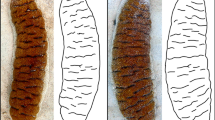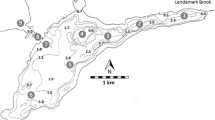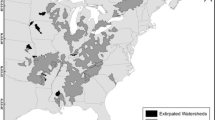Abstract
We measured for the first time movement, home range and site fidelity of the protected and endemic Australian fish weedy seadragon Phyllopteryx taeniolatus. Ninety-two individuals were identified using visual implant fluorescent elastomer and studied over a one-year period. Identified animals remained at the same site over the year within limited home ranges. These home ranges and the movement patterns recorded were independent of sex although movement to shallow sheltered waters to hatch the young was observed at the end of the breeding season for some pregnant males. The site fidelity and restricted home range of the weedy seadragon, as well as the reproduction-related movement have implications for effective management of this protected species.
Similar content being viewed by others
References
Bayer, R.D. 1980. Size, seasonality, and sex ratios of the bay pipefish (Syngnathus leptorhynchus) in Oregon. Northwest Sci. 54: 161-167.
Beukers, J.S., G.P. Jones & R.M. Buckley. 1995. Use of implant microtags for studies of populations of small reef fish. Mar. Ecol. Prog. Ser. 125: 61-66.
Berglund, A. & G. Rosenqvist. 1993. Selective males and ardent females in pipefishes. Behav. Ecol. Sociobiol. 32: 331-336.
Connolly, R.M., A.J. Melville & J.K.Keesing. 2002a. Abundance, movement and individual identification of leafy seadragons, Phycodurus eques (Pisces: Syngnathidae). Mar. Freshw. Res. 53: 777-780.
Connolly, R.M., A.J. Melville & K.M. Preston. 2002b. Patterns of movement and habitat use by leafy seadragons tracked ultrasonically. J. Fish. Biol. 61: 684-695.
Edgar, G.J. 2000. Australian Marine Life. The Plants and Animals of Temperate Waters. Reed New Holland. 425 pp.
Gronell, A.M. 1984. Courtship, spawning and social organization of the pipefish, Corythoichthys intestinalis (Pisces: Syngnathidae) with notes on two congeneric species. Z. Tierpsychol. 65: 1-24.
Herald, E.S. 1959. From pipefish to seahorse-a study of phylogenetic relationships. Proc. Calif. Acad. Sci. 29: 465-473.
Howard, R.K. & J.D. Koehn. 1985. Population dynamics and feeding ecology of pipefish (Syngnathidae) associated with eelgrass beds of Western Port, Victoria. Aust. J. Mar. Freshw. Res. 36: 361-70.
Hutchins, B.S. 1986. Sea Fishes of Southern Australia. Swainston Publishing, Perth. 95 pp.
Jones, A.G. & J.C. Avise. 2001. Mating systems and sexual selection in male-pregnant pipefish and seahorses: Insights from microsatellite-based studies of maternity. Amer. Genetic Assoc. 92: 150-158.
Kuiter, R.H. 1987. Note sur les soins parentaux, l'eclosion et l'elevage des Dragons de mer (Syngnathidae). Rev. Franc. Aquar. 14: 113-122.
Kuiter, R.H. 2000. Seahorses, Pipefish & Their Relatives. England: TMC publications. 79 pp.
Kuiter, R.H. 2001. Revision of the Australian seahorses of the genus Hippocampus (Syngnathiformes: Syngnathidae) with descriptions of nine newspecies. Rec. Aust. Mus. 53: 293-340.
Kvarnemo, C., G.I. Moore, A.G. Jones, W.S. Nelson & J.C.Avise. 2000. Monogamous pair bonds and mate switching in theWestern Australian seahorse Hippocampus subelongatus. J. Evol. Biol. 13: 882-888.
Lazzari, M. A. & K.W. Able. 1990. Northern pipefish, Syngnathus fuscus, occurrences over the Mid-Atlantic Bight continental shelf: Evidence of seasonal migration. Environ. Biol. Fish. 27: 177-185.
Lourie, S.A., J.C. Pritchard, S.P. Casey, S.K. Truong, H.J. Hall, & A.C.J. Vincent. 1999. The taxonomy of Vietnam's exploited seahorses (family Syngnathidae). Biol. J. Linn. Soc. 66: 231-256
Masonjones, H.D. & S.M. Lewis. 1996. Courtship behaviour in thedwarf seahorse, Hippocampus zosterae. Copeia 3: 634-640.
Morgan, R.I.G. & D.S. Paveley. 1996. A simple batch mark for fish studies using injected elastomer. Aqua. Res. 27: 631-633.
Olsen, E.M. & L.A. Vollestad. 2001. An evaluation of Visible Implant Elastomer for marking age-0 brown trout. N. Amer. J. Fish. Manag. 21: 967-970.
Payne, M.F. & R.J. Rippingale. 2000. Rearing West Australian seahorse, Hippocampus subelongatus, juveniles on copepod nauplii and enriched Artemia. Aquaculture 188: 353-361.
Vincent, A.C.J. & L.M. Sadler. 1995. Faithful pair bonds in wild seahorses, Hippocampus whitei. Anim. Behav. 50: 1557-1569.
Vincent, A.C.J., A. Berglund & I. Ahnesjo. 1995. Reproductive ecology of five pipefish species in one eelgrass meadow. Environ. Biol. Fish. 44: 347-361.
Woods, C.M.C. 2000. Improving Initial survival in cultured seahorses, Hippocampus abdominalis Leeson, 1827 (Teleostei: Syngnathidae). Aquaculture 190: 377-388.
Woods, C.M.C. & K.M. Martin-Smith (in press). Visible implant fluorescent elastomer tagging of the big-bellied seahorse, Hippocampus abdominalis. Fisheries Research.
Author information
Authors and Affiliations
Rights and permissions
About this article
Cite this article
Sanchez-Camara, J., Booth, D.J. Movement, Home Range and Site Fidelity of the Weedy Seadragon Phyllopteryx taeniolatus (Teleostei: Syngnathidae). Environmental Biology of Fishes 70, 31–41 (2004). https://doi.org/10.1023/B:EBFI.0000022850.33643.e3
Issue Date:
DOI: https://doi.org/10.1023/B:EBFI.0000022850.33643.e3




